Transitioning to an anti-inflammatory diet is a gradual process, not a sudden overhaul. The key is to make sustainable changes that you can stick with long-term, rather than aiming for perfection overnight. Here are some effective tips to help you transition smoothly:
1. Start Small and Gradually Replace:
Don’t feel pressured to completely clear out your pantry and fridge all at once. Begin by making one or two simple swaps each week. For instance, replace sugary sodas with water infused with fruit, or swap white bread for whole-grain options. Instead of processed snacks, reach for a handful of nuts or a piece of fruit. This incremental approach makes the change less daunting and more manageable, allowing your taste buds and habits to adjust over time.
2. Focus on Adding, Not Just Subtracting:
Instead of dwelling on what you can’t eat, shift your mindset to what you can add. Make it a goal to include more fruits and vegetables with every meal and snack. Try to “eat the rainbow” by choosing a wide variety of colorful produce, as different colors often signify different types of beneficial antioxidants. Experiment with new anti-inflammatory foods like turmeric, ginger, or various berries, incorporating them into your existing recipes. This positive framing helps build enthusiasm and expands your culinary horizons.
3. Prioritize Whole, Unprocessed Foods:
This is a cornerstone of an anti-inflammatory diet. Aim to replace processed and packaged foods with their whole-food counterparts. Choose fresh fruits and vegetables over canned or pre-packaged versions with added sugars or unhealthy fats. Opt for whole grains like brown rice, quinoa, and oats instead of refined grains like white bread and pasta. When buying ingredients, read labels carefully and choose items with minimal ingredients that you recognize.
4. Embrace Healthy Fats:
Healthy fats are crucial for an anti-inflammatory diet. Make extra virgin olive oil your primary cooking oil and dressing base. Incorporate sources of omega-3 fatty acids regularly, such as fatty fish (salmon, mackerel, sardines) at least two to three times a week. If you’re vegetarian or vegan, focus on plant-based omega-3 sources like flaxseeds, chia seeds, and walnuts. Avocados are also a fantastic source of anti-inflammatory monounsaturated fats.
5. Plan Your Meals and Snacks:
Meal planning can significantly ease the transition. Dedicate some time each week to plan your meals and create a grocery list based on anti-inflammatory principles. This reduces impulsive, unhealthy food choices. Consider batch cooking staples like whole grains, roasted vegetables, or lean proteins to have on hand for quick meals. Preparing healthy snacks like pre-cut vegetables with hummus, a handful of nuts, or fruit can prevent you from reaching for processed alternatives when hunger strikes. Being prepared is half the battle won when adopting a new eating style.
